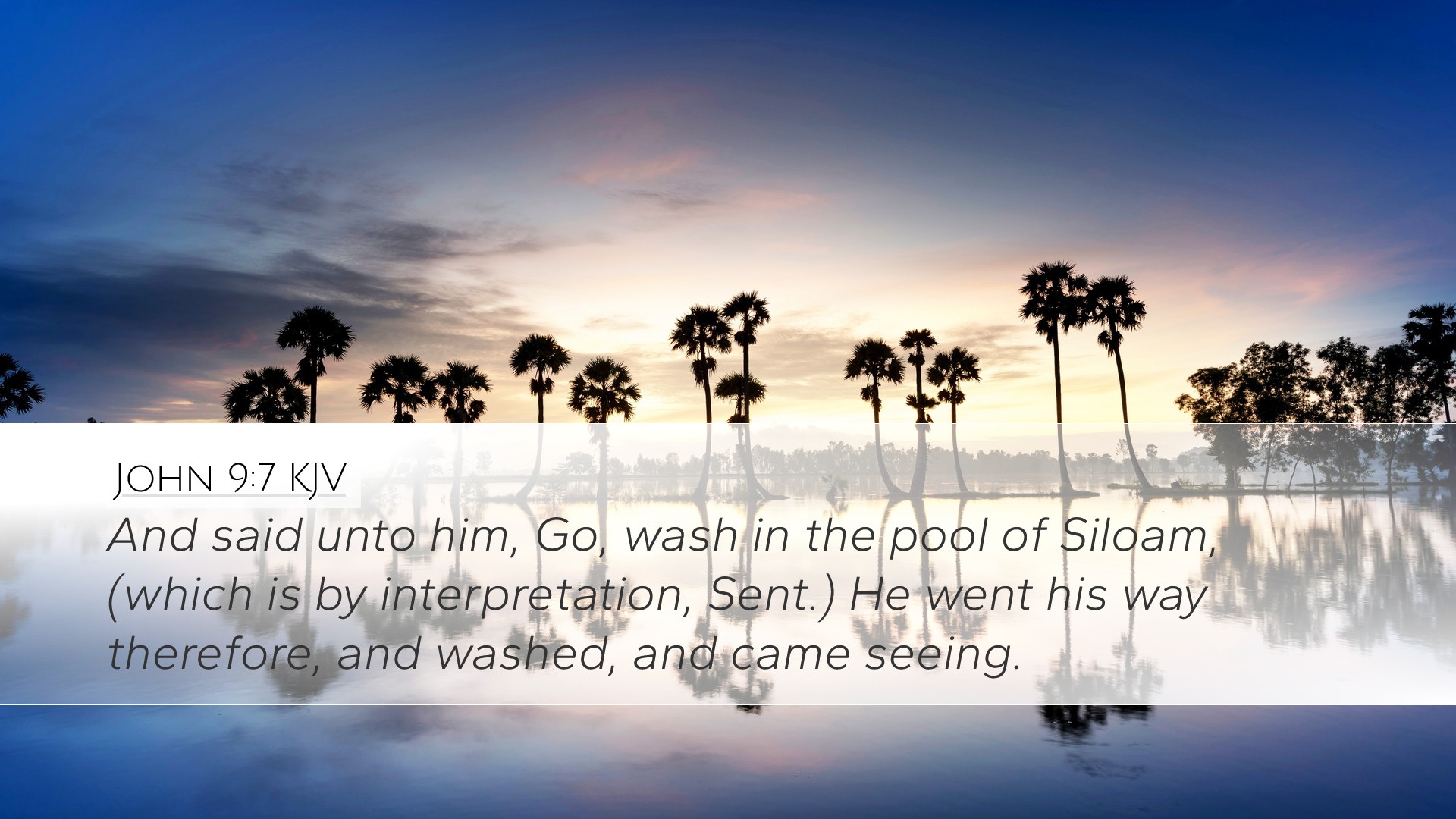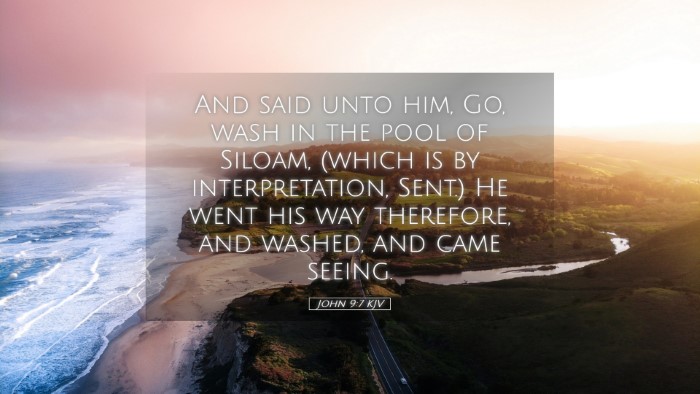Bible Commentary on John 9:7
John 9:7: "And said unto him, Go, wash in the pool of Siloam, (which is by interpretation, Sent.) He went his way therefore, and washed, and came seeing."
Introduction
This verse captures a pivotal moment in the narrative of the man born blind. As we delve into its meanings and implications, we will explore insights from various public domain commentaries, including those by Matthew Henry, Albert Barnes, and Adam Clarke. Each of these commentaries offers a unique perspective that can enrich our understanding of this significant event in the ministry of Jesus Christ.
Historical Context
The miracle of healing the blind man is set within the broader context of Jesus’ ministry in Jerusalem. It illustrates not only His compassion but also draws parallels to themes of spiritual blindness and illumination. Understanding the cultural and historical backdrop of this event is crucial for grasping its theological implications.
Insights from Matthew Henry
Matthew Henry notes that this act of healing is notable not just for the miracle itself but for the obedience required from the blind man. The command to wash in the pool of Siloam is a test of faith. Henry emphasizes the significance of the pool, which means "sent," suggesting that the act was divinely appointed and a part of God’s plan for the man’s healing.
- The Nature of Divine Healing: Henry highlights that God often requires cooperation from the individual receiving healing—a theme consistent throughout Scripture, where faith and action often go hand in hand.
- The Pool of Siloam: This pool was a symbol of purification and restoration. By directing the healed man to Siloam, Jesus underscored not only physical restoration but also spiritual renewal.
Insights from Albert Barnes
Albert Barnes offers a detailed analysis of the term "Siloam," elucidating its etymology and significance in the Jewish context. He argues that this command illustrates Jesus' method of healing, which often involved physical acts that required the faith and response of the individual.
- Symbolism of Washing: Barnes suggests this washing serves as a powerful symbol of not just physical sight, but also of the purification and spiritual awakening that comes from obedience to Christ. This connection between washing and spiritual rebirth resonates throughout the New Testament.
- Faith in Action: He underscores that the blind man’s willingness to obey Jesus’ command is crucial. It demonstrates the essential link between faith and works—an important consideration for theological discourse pertinent to justification and salvation.
Insights from Adam Clarke
Adam Clarke provides a thorough exegesis of the verse by examining the intricacies of the narrative. He points out that the act of washing at the pool signifies a transition for the man not just physically but also socially and spiritually.
- Transformation and Identity: Clarke notes how the man’s identity was bound up in his blindness. The act of washing signifies a new beginning—a theme present in many of Jesus' miracles where individuals are transformed from their past circumstances into new creations.
- Public Witness: The act of going to the pool was also a public demonstration of faith. Clarke emphasizes the communal aspects of Jesus' ministry, pointing out how healing is often witnessed by others, enhancing the miraculous nature of the event.
Theological Implications
The healing of the blind man in John 9:7 raises profound theological questions about sight and blindness, both physical and spiritual. This miracle illustrates the transformative power of Christ and the necessity of faith and obedience in experiencing divine intervention.
- Physical and Spiritual Sight: The miracle serves as an allegory for spiritual enlightenment. Just as the man receives physical sight through obedience, so too does humanity receive understanding through faith in Christ, providing important insights for pastoral teaching and spiritual growth.
- Jesus as Healer: The narrative reaffirms Jesus’ role as the healer, not only of physical ailments but also of spiritual blindness. This multifaceted approach to healing compels contemporary believers to seek complete restoration through Christ.
Conclusion
John 9:7 presents a compelling account of healing that encourages reflection on the nature of faith, obedience, and the transformative power of Christ. By examining this verse through the lenses of esteemed commentaries, we gain invaluable insights that serve pastors, students, and theologians alike. This moment of healing is not merely a historical event; it is a profound invitation for all believers to respond to God’s call for restoration, both physically and spiritually.


